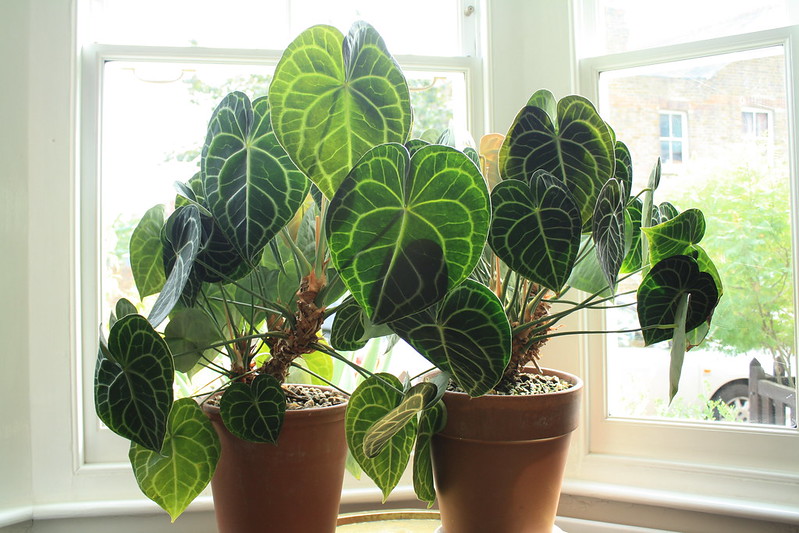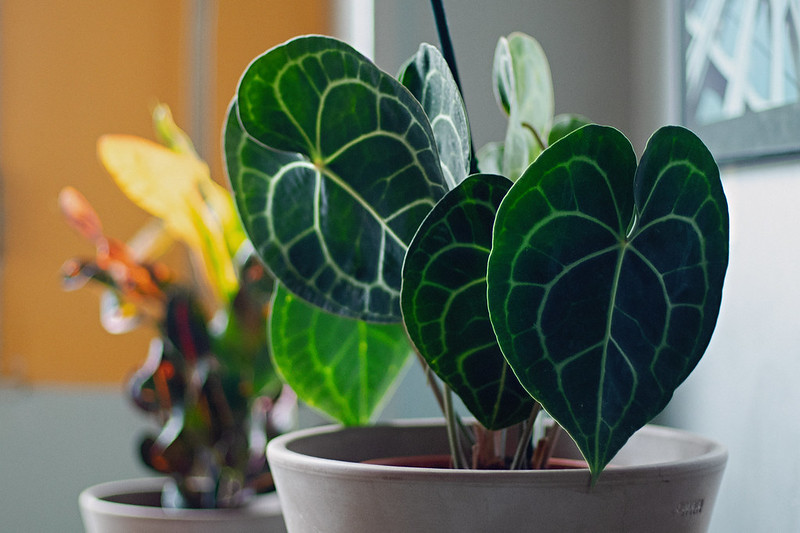Anthurium Clarinervium is one of the most famous and rare anthurium. They are super famous all over the internet due to their gorgeous dark green cardboard-like leaves with beautiful white veins this tropical plant has become increasingly popular in homes and gardens.
Whether you’re a seasoned plant lover or just starting your green journey, this comprehensive guide will provide you with all the information you need to successfully grow and care for Anthurium Clarinervium.
What is Anthurium Clarinervium
Before delving into the intricacies of growing and caring for Anthurium Clarinervium, it’s essential to understand the basics of this unique plant.
Anthurium Clarinervium is native to the rainforests of southern Mexico and belongs to the Araceae family. It is also commonly known as the “Queen Anthurium” or “Velvet Cardboard Anthurium.”
One of the defining features of Anthurium Clarinervium is its large, heart-shaped leaves. These leaves are dark green and have prominent white or silver veins running through them, giving them an eye-catching appearance.
The plant can grow up to 30 inches tall and spread up to 18 inches wide, making it an ideal choice for both indoor and outdoor gardens.
| Botanical Name | Anthurium clarinervium |
|---|---|
| Common Name | Velvet Cardboard Anthurium |
| Family | Araceae |
| Genus | Anthurium |
| Plant Type | Perennial, Epiphyte |
| Native Region | Mexico |
| Mature Height | Up to 3 feet (90 cm) |
| Light Requirements | Bright, indirect light |
| Watering Needs | Moderate |
| Soil Type | Well-draining, aerated |
| Humidity Preferences | High humidity preferred |
| Temperature Range | 65-80°F (18-27°C) |
| Flower Color | Greenish-white |
| Special Features | Velvety, heart-shaped leaves with prominent veins |
Benefits: –
Enjoy the stunning beauty of Anthurium Clarinervium and impress your guests with its unique texture and pattern.-
Breathe easier with this plant’s natural air-purifying qualities, which can help improve indoor air quality and create a healthier environment.-
Take advantage of the low-maintenance care requirements, perfect for busy lifestyles and individuals who want to enjoy the benefits of nature without the hassle.-
Create a sense of calm and tranquility in your home with the natural beauty of this plant.

Best Growing Conditions of Anthurium Clarinervium
To help your Anthurium Clarinervium thrive, it’s crucial to provide optimal growing conditions. Let’s explore the key factors that contribute to the plant’s well-being.
Light Requirements
Anthurium Clarinervium blooms in bright, indirect light. It can tolerate some early morning or late afternoon direct sunlight, But prolonged exposure to strong sunlight may cause its leaves to get scorched.
Place your plant near a north or east-facing window, ensuring it receives ample bright, filtered light throughout the day.
If natural light is limited, you can supplement it with artificial fluorescent lights placed a few feet above the plant.
Temperature and Humidity
Anthurium Clarinervium flourishes in warm, tropical temperatures. The ideal temperature range for this plant is between 65°F and 80°F (18°C and 27°C) during the day and around 60°F to 70°F (15°C to 21°C) during the night.
Keep it away from drafts and sudden temperature fluctuations, which can negatively impact its growth.
Additionally, Anthurium Clarinervium thrives in high-humidity environments. Ideally, aim for a humidity level of 60% or higher.
You can increase humidity around the plant by misting it regularly, placing a tray of water nearby, or using a humidifier.
Avoid placing the plant near heating or cooling vents, as the dry air can be detrimental to its health.

Soil Requirements
The right soil mixture is essential for the healthy growth of Anthurium Clarinervium. It prefers a well-draining potting mix that retains some moisture without becoming waterlogged.
A suitable mixture can be made by combining equal parts of peat moss, perlite, and orchid bark. This blend provides good aeration while also retaining the right amount of moisture.
Watering
Proper watering is crucial for the well-being of Anthurium Clarinervium. Aim to keep the soil slightly moist but not overly wet.
Water the plant thoroughly when the top inch of soil feels dry to the touch. Ensure that excess water drains out of the pot, as waterlogged soil can lead to root rot.
Avoid overwatering as it can cause the roots to suffocate and eventually rot. On the other hand, underwatering can cause the plant to wilt and adversely affect its growth.
Strike a balance by monitoring the soil moisture levels regularly and adjusting your watering routine accordingly.
Fertilization
Anthurium Clarinervium benefits from regular fertilization during the growing season. Use a balanced, water-soluble fertilizer with a ratio of 20-20-20 or a specifically formulated fertilizer for Anthuriums.
Dilute the fertilizer to half or a quarter of the recommended strength and apply it every four to six weeks. Always follow the instructions provided on the fertilizer packaging for proper application.
Propagation
If you wish to expand your collection of Anthurium Clarinervium or share the joy of growing this beautiful plant with others, propagation is the way to go.
The most common method of propagation for Anthurium Clarinervium is through division.
- Start by preparing a new pot with a well-draining potting mix.
- Gently remove the mother plant from its pot, being careful not to damage the roots.
- Inspect the plant and identify any natural divisions or separate offshoots.
- Using a clean, sharp knife or shears, carefully separate these divisions from the mother plant, ensuring that each division has healthy roots and leaves.
- Plant each division in its separate pot, making sure the roots are covered with soil and the leaves are above the surface.
- Water the newly potted divisions lightly, and place them in a warm, humid location with indirect light.
- Maintain a high humidity level by covering the pots with a plastic bag or using a misting system.
- In a few weeks, you should start to see signs of new growth, indicating successful propagation.

Common Issues and How to Overcome Them
Even with the best care, Anthurium Clarinervium may encounter some challenges. Let’s take a look at some common issues and how to address them.
Pest Infestations
Anthurium Clarinervium can fall victim to pests such as mealybugs and spider mites. Regularly inspect your plant for signs of pest infestation, such as webbing, tiny black spots, or cotton-like clusters.
If you notice any pests, isolate the plant to prevent infestation spread and treat it with suitable insecticide or organic pest control methods.
Follow the instructions on the product carefully and repeat the treatment if necessary.
Leaf Browning or Yellowing
Browning or yellowing leaves can be caused by various factors, including overwatering, underwatering, excessive sunlight exposure, or nutrient deficiencies.
Assess the plant’s growing conditions and make appropriate adjustments. Ensure proper watering, provide adequate shade if needed, and consider fertilizing with suitable plant food to address any nutrient deficiencies.
Root Rot
Overwatering or poorly draining soil can lead to root rot, a condition where the roots become saturated and begin to decay.
To prevent root rot, ensure proper drainage by using a well-draining potting mix and a pot with drainage holes. Be mindful of your watering routine and allow the soil to dry out slightly between waterings.
In Conclusion
Growing and caring for Anthurium Clarinervium can be an immensely rewarding experience. By providing the plant with the right growing conditions, including adequate light, temperature, humidity, soil, and water, you can encourage its optimal growth and vibrant foliage.
Remember to regularly inspect your plant for any signs of pests or issues and take prompt action if necessary.
The Anthurium Clarinervium is a true gem among houseplants, and it’s sure to become the centerpiece of your indoor oasis.
With its unique texture and low-maintenance care requirements, this plant is the perfect choice for anyone who wants to add a touch of natural beauty to their home.
So go ahead, embrace your green thumb, and embark on this delightful journey of growing and caring for Anthurium Clarinervium!
| Yes, Anthuriums are considered toxic to cats. The plant contains calcium oxalate crystals, which, if ingested, can cause irritation and swelling in the mouth, throat, and gastrointestinal tract. This can lead to symptoms such as drooling, difficulty swallowing, and vomiting. In more severe cases, it may cause swelling of the upper airway, making it difficult for the cat to breathe. |
FAQs
1. Is Anthurium Clarinervium hard to care for?
- Anthurium Clarinervium can be considered moderately challenging to care for. It requires specific conditions, including high humidity, indirect light, well-draining soil, and consistent moisture. Providing these conditions can contribute to successful care and growth.
2. Is Anthurium Clarinervium rare?
- Anthurium Clarinervium is considered a rare and sought-after plant due to its distinctive heart-shaped leaves with prominent veins. Its limited availability in the market contributes to its reputation as a rare and prized Anthurium species among plant enthusiasts.
3. How do you look after Anthurium Clarinervium?
- Key care tips for Anthurium Clarinervium include:
- Light: Indirect, bright light is preferable; avoid direct sunlight.
- Humidity: High humidity is essential; consider using a humidifier.
- Watering: Keep the soil consistently moist but not waterlogged.
- Soil: Well-draining and aerated soil mix is ideal.
- Temperature: Maintain a warm environment, avoiding temperature extremes.
4. How fast do Anthurium Clarinervium grow?
- Anthurium Clarinervium is not known for fast growth. It typically grows slowly, and the rate can be influenced by factors such as environmental conditions, care practices, and the plant’s maturity. Patience is required when cultivating this plant, as it may take time to reach its full size.

